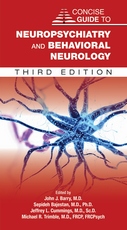Brain Circuitry and Signaling in Psychiatry
Basic Science and Clinical Implications
View Pricing
Description
The 1990s, appropriately termed the decade of the brain, witnessed unprecedented advances in our knowledge of psychiatric neuroscience. Yet with every advance, we realized afresh that we were still in the beginning stages of a much longer journey.
This text chronicles the next step of that journey. Structured around a proven teaching methodology that uniquely integrates the clinical aspects of psychiatric disorders with their neurobiology, this volume begins with two introductory chapters on functional neural circuitry and neural signaling pathways. The remaining six chapters present current knowledge on the neuroanatomic and neurochemical mechanisms underlying schizophrenia, addiction, anxiety, depression, bipolar disorder, and dementia/Alzheimer's disease. For clarity and consistency, each chapter features the same four divisions—clinical presentation, neural circuitry, signaling pathways, and psychopharmacology—as they relate to
- Schizophrenia, which reviews studies of the neural basis of schizophrenia and describes how the cortex, the thalamus, the basal ganglia, and the medial temporal lobe work together during normal brain function and then how each is perturbed in psychosis.
- Addiction, which focuses on the consequences of psychoactive substance use, including compulsive practices (e.g., eating, sex, Internet browsing) that might also involve the same brain circuits and signaling pathways. Of exceptional value are two unique illustrations that capture—for the first time—much of what we know about the anatomy and neurochemistry underlying the behavioral symptoms of addiction.
- Anxiety, which presents current hypotheses regarding neurocircuitry and signaling pathways for the three best-studied (from a neurobiologic perspective) anxiety disorders: panic disorder, posttraumatic stress disorder, and obsessive-compulsive disorder.
- Depression, which offers evidence for the involvement of highly interconnected cortical and limbic structures such as the prefrontal cortex, medial thalamus, amygdala, ventral striatum, hippocampus, and the hypothalamic-pituitary-adrenal axis in unipolar major depression, and suggests target areas (such as the cAMP pathway) for study in the development of new antidepressants.
- Bipolar disorder, which shows that specific abnormalities in signal transduction pathways, including protein kinase activity, G protein levels, and gene expression, are unique to bipolar patients, concluding that the actions of lithium and anticonvulsants on intracellular signaling pathways provide a new paradigm for novel pharmacological interventions.
- Dementia and Alzheimer's disease, which details current findings on neurofibrillary degeneration, relevant genes and proteins, pathogenesis (metabolic decline, defective cell repair, and Aß toxicity), and treatment strategies (neurotransmitter replacement, and neuroprotective and regenerative approaches). Discusses frontotemporal dementia, dementia with Lewy bodies, Parkinson's disease, and vascular dementia.
Meticulously researched and clearly written by 15 contributors—all recognized experts from leading research and teaching institutions in the United States—this compact and extensively illustrated volume stands out in the literature because it combines readability and practicality with the breadth and depth typically found only in far lengthier works. Psychiatric practitioners, residents, and students alike will welcome this informative, easy-to-read text, which will also be of special interest to mental health and pharmaceutical industry professionals, and of general interest to anyone who wants to know more about the biology of psychiatric illness.
Contents
- Contributors
- Introduction to the Progress in Psychiatry Series
- Preface
- Chapter 1. Introduction to Functional Neural Circuitry
- Chapter 2. Introduction to Neuronal Signaling Pathways
- Chapter 3. Neural Circuitry and Signaling in Schizophrenia
- Chapter 4. Neural Circuitry and Signaling in Addiction
- Chapter 5. Neural Circuitry and Signaling in Anxiety
- Chapter 6. Neural Circuitry and Signaling in Depression
- Chapter 7. Neural Circuitry and Signaling in Bipolar Disorder
- Chapter 8. Neural Circuitry and Signaling in Dementia and Alzheimer's Disease
- Index
About the Authors
Gary B. Kaplan, M.D., is Associate Professor in the Departments of Psychiatry and Human Behavior and Molecular Pharmacology, Physiology, and Biotechnology at Brown University School of Medicine and Veterans Affairs Medical Center in Providence, Rhode Island.
Ronald P. Hammer Jr., Ph.D., is Professor in the Departments of Psychiatry, Anatomy, Pharmacology, and Neuroscience at Tufts University School of Medicine and Laboratory of Research in Psychiatry, New England Medical Center in Boston, Massachusetts.
Related Products
Carousel Control - items will scroll by tabbing through them, otherwise arrows can be used to scroll one item at a time








